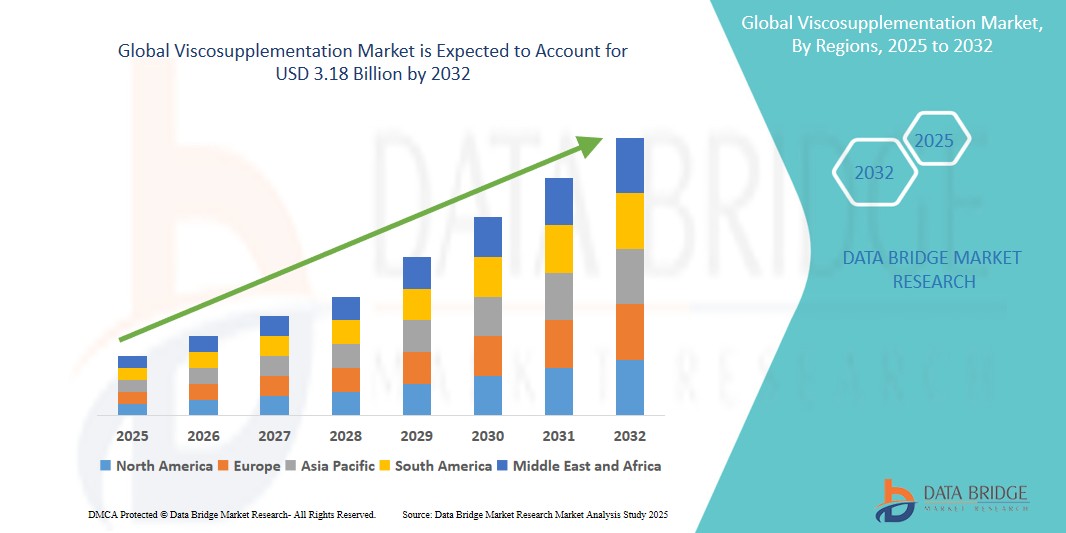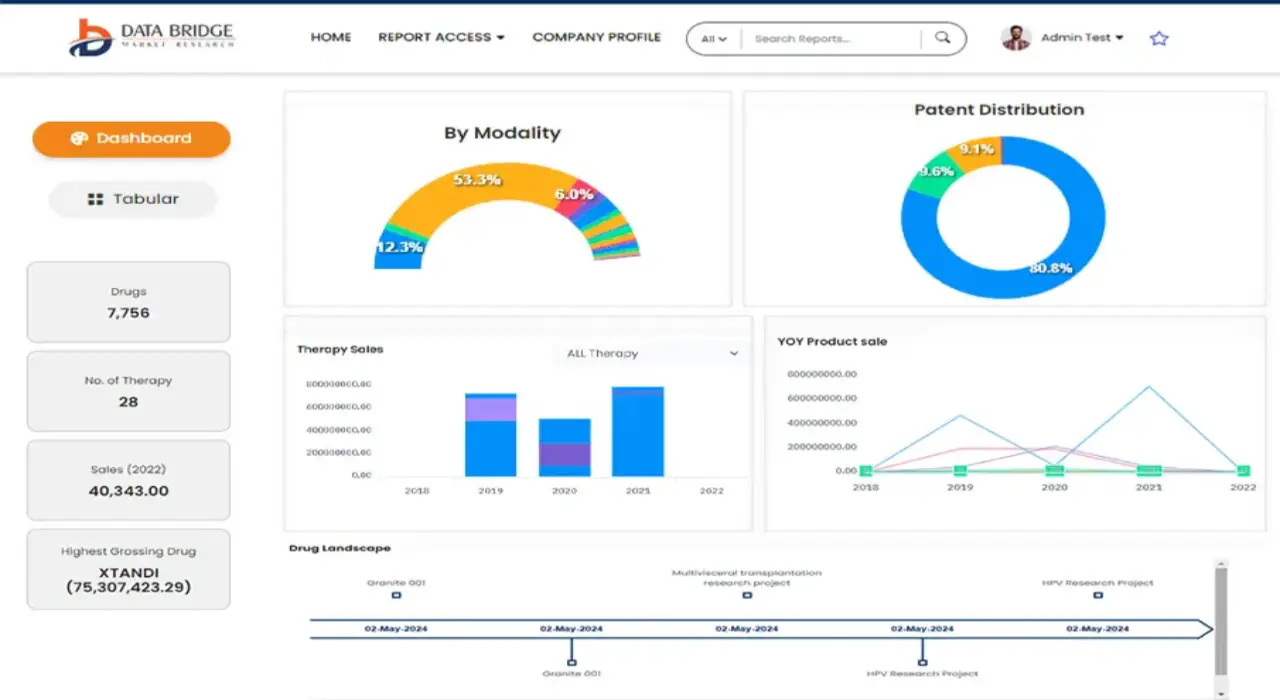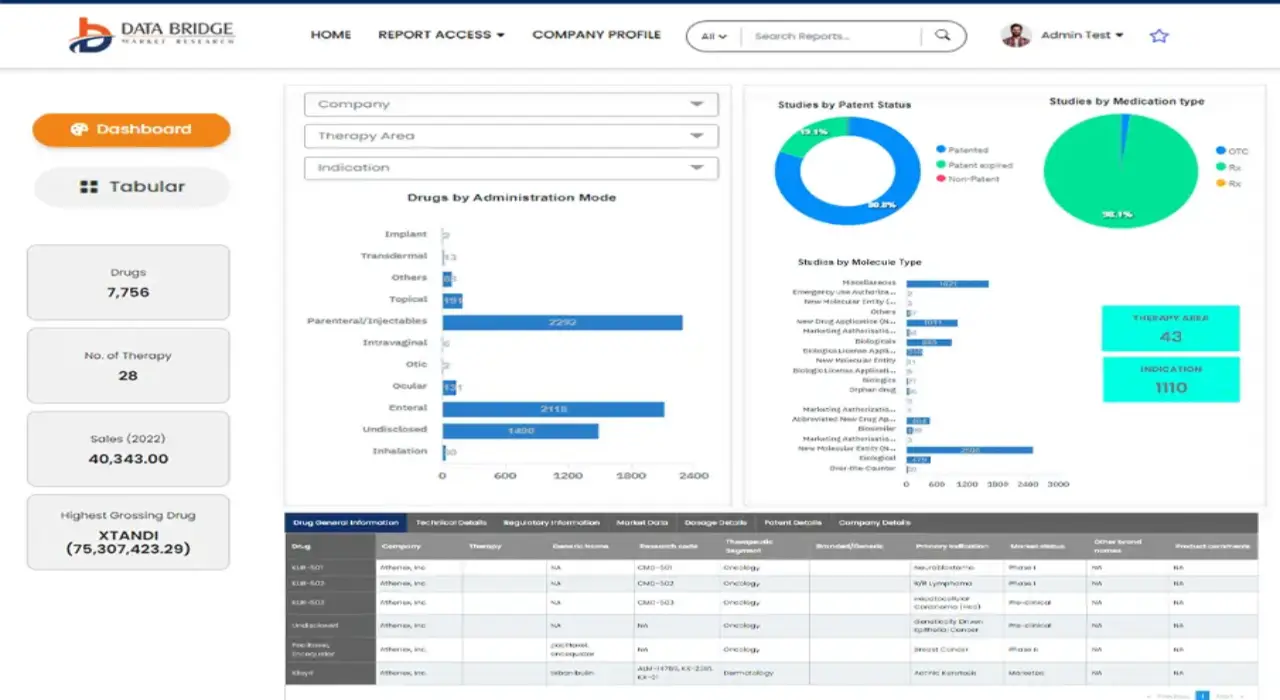Global Viscosupplementation Market
Market Size in USD Billion
CAGR :
% 
 USD
1.66 Billion
USD
3.18 Billion
2024
2032
USD
1.66 Billion
USD
3.18 Billion
2024
2032
| 2025 –2032 | |
| USD 1.66 Billion | |
| USD 3.18 Billion | |
|
|
|
|
Global Viscosupplementation Market Segmentation, By Source (Animal Origin and Non-Animal Origin), Age Group (Geriatric and Adults), Injection (Single Injection, Three Injections, and Five Injections), Molecular Weight (Intermediate Molecular Weight, Low Molecular Weight, and High Molecular Weight), End User (Hospital, Orthopedic Clinics, Ambulatory Care Centers, and Others), Distribution Channel (Direct Tender and Retail Sales)- Industry Trends and Forecast to 2032
Viscosupplementation Market Size
- The global viscosupplementation market size was valued at USD 1.66 billion in 2024 and is expected to reach USD 3.18 billion by 2032, at a CAGR of 8.50 % during the forecast period
- This growth is driven by factors such as the increasing prevalence of osteoarthritis and the rising demand for minimally invasive treatments that improve joint mobility and reduce pain without surgery
Viscosupplementation Market Analysis
- The viscosupplementation market is steadily growing as more individuals seek effective non-surgical options to manage joint pain and maintain mobility. This trend reflects a shift toward treatment approaches that offer relief with fewer side effects and quicker recovery times compared to traditional methods
- Healthcare providers are increasingly recommending viscosupplementation treatments to patients with moderate osteoarthritis symptoms who wish to delay or avoid surgery. The market is seeing continued investment in product innovation and procedural advancements to meet the evolving needs of both patients and clinicians
- North America is expected to dominate the viscosupplementation market due to its advanced healthcare infrastructure, high adoption rate of innovative treatments, and the growing prevalence of osteoarthritis in the aging population.
- Asia-Pacific is expected to be the fastest growing region in the viscosupplementation market during the forecast period due to a rapidly aging population, improving healthcare access, and increasing awareness of joint health treatments in emerging economies such as China and India.
- The three-injection regimen segment is expected to dominate the viscosupplementation market with the largest share of 48.9% in 2025 due to its established clinical efficacy, long-standing usage by healthcare professionals, and ability to provide sustained pain relief in moderate osteoarthritis cases.
Report Scope and Viscosupplementation Market Segmentation
|
Attributes |
Viscosupplementation Key Market Insights |
|
Segments Covered |
|
|
Countries Covered |
North America
Europe
Asia-Pacific
Middle East and Africa
South America
|
|
Key Market Players |
|
|
Market Opportunities |
|
|
Value Added Data Infosets |
In addition to the insights on market scenarios such as market value, growth rate, segmentation, geographical coverage, and major players, the market reports curated by the Data Bridge Market Research also include depth expert analysis, patient epidemiology, pipeline analysis, pricing analysis, and regulatory framework. |
Viscosupplementation Market Trends
“Rising Preference for Single-Injection Viscosupplementation Treatments”
- There is a growing preference for single-injection viscosupplementation therapies as they offer greater convenience and require fewer clinic visits compared to traditional multi-injection regimens
- For instance, Durolane is a widely used single-injection treatment that provides long-lasting knee pain relief with minimal disruption to patients’ routines
- The development of high-molecular-weight hyaluronic acid formulations has enabled effective treatment outcomes from a single dose, reducing the need for repeat administration
- For instance, Monovisc, a single-injection product, has gained FDA approval and is known for its strong efficacy in managing osteoarthritis symptoms
- These single-injection solutions are increasingly adopted in clinical practice due to their ability to reduce discomfort and streamline the patient experience
- Single-injection options contribute to better patient compliance and reduce overall healthcare costs by minimizing repeated appointments and associated expenses
- Healthcare providers and clinics favor these treatments for their ease of administration, especially in high-volume settings where time and resources are limited
Viscosupplementation Market Dynamics
Driver
“Rising Prevalence of Osteoarthritis”
- The growing global burden of osteoarthritis, particularly knee osteoarthritis, is a major driver of the viscosupplementation market, as it leads to pain and mobility loss in millions of elderly patients
- For instance, the World Health Organization estimates that over 528 million people suffer from osteoarthritis worldwide, with knee osteoarthritis being the most common type
- As the aging population increases, there is a rising preference for non-surgical, minimally invasive treatments that offer effective relief, such as hyaluronic acid injections
- For instance, in countries such as Japan and Italy, where the elderly population exceeds 20%, viscosupplementation demand has steadily increased
- Viscosupplementation helps restore synovial fluid viscosity, which cushions the joints and reduces inflammation, thereby improving joint function and reducing pain
- Patients who are ineligible or unwilling to undergo knee replacement surgery often choose viscosupplementation due to its lower risks and fewer complications
- Increased public awareness and early osteoarthritis diagnosis, especially in urban centers with advanced healthcare facilities, are accelerating the adoption of these therapies and expanding market size
Opportunity
“Shift Toward Personalized and Targeted Treatment Plans”
- Personalized viscosupplementation treatment plans are gaining traction, allowing therapies to be tailored based on the patient’s joint condition, severity, and health profile
- For instance, advanced diagnostic imaging techniques such as MRI and ultrasound help assess joint degeneration levels more precisely for targeted therapy
- Technology advancements in biomarkers and diagnostics enable providers to select the appropriate hyaluronic acid formulation, dosage, and frequency of administration for each patient
- Integration with complementary treatments such as physical therapy or anti-inflammatory medications enhances overall effectiveness and patient satisfaction
- Digital health tools and artificial intelligence now enable real-time tracking of patient progress, allowing clinicians to adjust the regimen dynamically for optimal outcomes
- For instance, AI-based platforms such as IBM Watson Health assist in decision-making for customized osteoarthritis management plans
- As healthcare shifts toward value-based care, personalized viscosupplementation improves outcomes and creates a competitive edge for manufacturers and providers through patient-centric solutions
Restraint/Challenge
“Lack of Uniform Clinical Guidelines and Reimbursement Limitations”
- Inconsistent clinical guidelines across countries create uncertainty for healthcare professionals about when to recommend viscosupplementation, especially in advanced osteoarthritis
- For instance, while the American College of Rheumatology does not strongly endorse viscosupplementation, other regional bodies support its use in early stages
- Limited insurance reimbursement coverage in many regions acts as a barrier, making the treatment unaffordable for patients and restricting its market penetration
- Cost constraints are particularly challenging in public healthcare systems and among lower-income groups, where out-of-pocket expenses discourage elective treatments
- Lack of standardization in product formulations and injection techniques leads to varied patient outcomes, fueling skepticism among clinicians and patients alike
- For instance, Differences between low and high molecular weight hyaluronic acid injections, such as Synvisc vs Hyalgan, contribute to inconsistent efficacy
- Addressing these challenges requires long-term clinical evidence and coordinated efforts among regulators, manufacturers, and healthcare providers to create unified usage and coverage policies
Viscosupplementation Market Scope
The market is segmented on the basis of source, age group, injection, molecular weight, end user, and distribution channel.
|
Segmentation |
Sub-Segmentation |
|
By Source |
|
|
By Age Group |
|
|
By Injection |
|
|
By Molecular Weight |
|
|
By End User |
|
|
By Distribution Channel |
|
In 2025, the three-injection regimen is projected to dominate the market with a largest share in injection segment
The three-injection regimen segment is expected to dominate the viscosupplementation market with the largest share of 48.9% in 2025 due to its established clinical efficacy, long-standing usage by healthcare professionals, and ability to provide sustained pain relief in moderate osteoarthritis cases
The high molecular weight is expected to account for the largest share during the forecast period in molecular weight market
In 2025, the high molecular weight segment is expected to dominate the market with the largest market share of 69.3% due to its superior viscoelastic properties that mimic natural synovial fluid, offering enhanced joint lubrication, prolonged effectiveness, and greater patient satisfaction
Viscosupplementation Market Regional Analysis
“North America Holds the Largest Share in the Viscosupplementation Market”
- North America is expected to dominate the viscosupplementation market with the largest market share of approximately 45.3% in 2025
- The high prevalence of knee osteoarthritis in North America boosts the demand for non-surgical treatments such as viscosupplementation
- The presence of key market players and extensive research facilities enhances product availability and innovation
- Insurance coverage for viscosupplementation treatments in North America is a key driver of market growth
- The region has a well-established distribution network and regulatory support for new therapies, fuelling market expansion
“Asia-Pacific is Projected to Register the Highest CAGR in the Viscosupplementation Market”
- Asia-Pacific is expected to be the fastest-growing region in the viscosupplementation market due to rapid urbanization, increasing healthcare awareness, and rising healthcare spending
- The growing geriatric population is also contributing to the demand for joint-related treatments
- The rising incidence of osteoarthritis and the growing demand for non-invasive treatments are driving market growth in the region
- Increasing disposable income in countries such as China and India is enabling more patients to afford advanced medical therapies
- Government initiatives aimed at improving healthcare access and infrastructure are supporting market growth
- The growing awareness of osteoarthritis management and treatment options among patients and healthcare providers is expanding the market in this region
Viscosupplementation Market Share
The market competitive landscape provides details by competitor. Details included are company overview, company financials, revenue generated, market potential, investment in research and development, new market initiatives, global presence, production sites and facilities, production capacities, company strengths and weaknesses, product launch, product width and breadth, application dominance. The above data points provided are only related to the companies' focus related to market.
The Major Market Leaders Operating in the Market Are:
- Anika Therapeutics, Inc. (U.S.)
- SEIKAGAKU CORPORATION (Japan)
- Bioventus (U.S.)
- Fidia Farmaceutici S.P.A (Italy)
- Ferring B.V (Netherlands)
- sanofi-aventis U.S. LLC (U.S.)
- Zimmer Biomet (U.S.)
- OrthogenRx, Inc. (U.S.)
- APTISSEN (France)
- Johnson & Johnson Services, Inc. (U.S.)
- LG Chem. (South Korea)
- Viatris Inc. (U.S.)
- IBSA Institut Biochimique SA (Switzerland)
- Ortobrand International (U.S.)
- TRB CHEMEDICA SA (Switzerland)
- Teva Pharmaceutical Industries Ltd. (Israel)
- Lifecore (U.S.)
- VIRCHOW BIOTECH (India)
- Zuventus HealthCare Ltd (India)
Latest Developments in Global Viscosupplementation Market
- In May 2025, Johnson & Johnson's Janssen Pharmaceuticals announced that Tremfya (guselkumab) is the first and only IL-23 inhibitor to significantly reduce both the signs and symptoms and the progression of structural damage in adults living with active psoriatic arthritis. This approval, based on clinical trials, shows significant improvement in joint symptoms, skin lesions, and patient-reported outcomes. Tremfya offers a new option for patients with treatment-resistant active psoriatic arthritis, aiming to improve patient quality of life and expand the treatment landscape. It is expected to make a significant impact in the market due to its unique mechanism of action and effectiveness
- In August 2021, Seikagaku Corporation launched HyLink, a single-injection viscosupplement for knee osteoarthritis in Taiwan. Developed using proprietary cross-linking technology, HyLink offers long-lasting relief with a single 3 mL injection. The product complements Seikagaku’s existing portfolio, including ARTZDispo and Artzfors. This launch strengthens Seikagaku's position in Taiwan, addressing the rising demand for effective osteoarthritis treatments, especially among the aging population
SKU-
Get online access to the report on the World's First Market Intelligence Cloud
- Interactive Data Analysis Dashboard
- Company Analysis Dashboard for high growth potential opportunities
- Research Analyst Access for customization & queries
- Competitor Analysis with Interactive dashboard
- Latest News, Updates & Trend analysis
- Harness the Power of Benchmark Analysis for Comprehensive Competitor Tracking
Research Methodology
Data collection and base year analysis are done using data collection modules with large sample sizes. The stage includes obtaining market information or related data through various sources and strategies. It includes examining and planning all the data acquired from the past in advance. It likewise envelops the examination of information inconsistencies seen across different information sources. The market data is analysed and estimated using market statistical and coherent models. Also, market share analysis and key trend analysis are the major success factors in the market report. To know more, please request an analyst call or drop down your inquiry.
The key research methodology used by DBMR research team is data triangulation which involves data mining, analysis of the impact of data variables on the market and primary (industry expert) validation. Data models include Vendor Positioning Grid, Market Time Line Analysis, Market Overview and Guide, Company Positioning Grid, Patent Analysis, Pricing Analysis, Company Market Share Analysis, Standards of Measurement, Global versus Regional and Vendor Share Analysis. To know more about the research methodology, drop in an inquiry to speak to our industry experts.
Customization Available
Data Bridge Market Research is a leader in advanced formative research. We take pride in servicing our existing and new customers with data and analysis that match and suits their goal. The report can be customized to include price trend analysis of target brands understanding the market for additional countries (ask for the list of countries), clinical trial results data, literature review, refurbished market and product base analysis. Market analysis of target competitors can be analyzed from technology-based analysis to market portfolio strategies. We can add as many competitors that you require data about in the format and data style you are looking for. Our team of analysts can also provide you data in crude raw excel files pivot tables (Fact book) or can assist you in creating presentations from the data sets available in the report.













